Assessing Floods and Droughts in Ungauged Small Reservoirs with Long-Term Landsat Imagery
Abstract
:1. Introduction
1.1. Small Water Bodies in Agriculture
1.2. Remote Sensing in Hydrology
2. Materials and Methods
2.1. Water Detection Principles
2.2. Small Reservoirs in the Merguellil Upper Catchment
2.3. Inventory of Small Reservoirs
2.4. Grid Cell Definition for Automation
2.5. Chain of Treatments on Landsat Imagery
2.6. Surface-Volume Rating Curves
2.6.1. Power Relations
2.6.2. Validating a Common S-V Power Relation
2.7. Accounting for Silting in Power Relations
3. Results and Discussion
3.1. Method Performance on Ungauged Lakes
3.1.1. Daily Flood Dynamics and Water Volumes
3.1.2. Quantifying Mean Annual Water Volumes/Availability
3.1.3. Timing and Duration of Droughts
3.2. Monitoring and Quantifying Droughts
3.2.1. Water Availability Variability across Lakes and Years
3.2.2. Quantifying Drought Frequencies
3.2.3. Uncertainties over Silting
3.2.4. Relationship between Capacity and Droughts
4. Conclusions
Acknowledgments
Author Contributions
Conflicts of Interest
References
- Centre National des Etudes Agricoles (CNEA). Etude d’impact des Travaux de Conservation des Eaux et du sol dans le Gouvernorat de Kairouan; Technical Report; CNEA: Tunis, Tunisie, 2006. (In French) [Google Scholar]
- Wisser, D.; Frolking, S.; Douglas, E.M.; Fekete, B.M.; Schumann, A.H.; Vörösmarty, C.J. The significance of local water resources captured in small reservoirs for crop production—A global-scale analysis. J. Hydrol. 2010, 384, 264–275. [Google Scholar] [CrossRef]
- Albergel, J.; Nasri, S.; Boufaroua, M.; Droubi, A.; Merzouk, A.A. Petits barrages et lacs collinaires, aménagements originaux de conservation des eaux et de protection des infrastructures aval: Exemples des petits barrages en Afrique du Nord et au Proche Orient. Sécheresse 2004, 15, 78–86. (In French) [Google Scholar]
- Bouma, J.A.; Biggs, T.W.; Bouwer, L.M. The downstream externalities of harvesting rainwater in semi-arid watersheds: An Indian case study. Agric. Water Manag. 2011, 98, 1162–1170. [Google Scholar] [CrossRef]
- Burte, J.; Coudrain, A.; Frischkorn, H.; Chaffaut, I.; Kosuth, P. Impacts anthropiques sur les termes du bilan hydrologique d’un aquifère alluvial dans le Nordeste semi-aride, Brésil. Hydrol. Sci. J. 2005, 50, 95–110. (In French) [Google Scholar] [CrossRef]
- Venot, J.P.; Krishnan, J. Discursive framing: Debates over small reservoirs in the Rural South. Water Altern. 2011, 4, 316–324. [Google Scholar]
- Khlifi, S.; Ameur, M.; Mtimet, N.; Ghazouani, N.; Belhadj, N. Impacts of small hill dams on agricultural development of hilly land in the Jendouba region of northwestern Tunisia. Agric. Water Manag. 2010, 97, 50–56. [Google Scholar] [CrossRef]
- Mugabe, F.; Hodnett, M.; Senzanje, A. Opportunities for increasing productive water use from dam water: A case study from semi-arid Zimbabwe. Agric. Water Manag. 2003, 62, 149–163. [Google Scholar] [CrossRef]
- Kongo, V.; Jewitt, G. Preliminary investigation of catchment hydrology in response to agricultural water use innovations: A case study of the Potshini catchment—South Africa. Phys. Chem. Earth 2006, 31, 976–987. [Google Scholar] [CrossRef]
- Lacombe, G. Evolution et Usages de la Ressource en eau dans un Bassin Versant Amenagé Semi-Aride. Le Cas du Merguellil en Tunisie Centrale. Ph.D. Thesis, Université Montpellier II, Montpellier, France, 2007. [Google Scholar]
- Li, Q.; Gowing, J. A daily water balance modelling approach for simulating performance of tank-based irrigation systems. Water Resour. Manag. 2005, 19, 211–231. [Google Scholar] [CrossRef]
- Ogilvie, A. Upscaling Water Availability and Water Use Assessments in Hydro-Sociosystems: The Small Reservoirs of the Merguellil Catchment (Central Tunisia). Ph.D. Thesis, Université de Montpellier, Montpellier, France, King’s College London, London, UK, 2015. Available online: https://hal.archives-ouvertes.fr/tel-01341741 (accessed on 19 September 2016). [Google Scholar]
- Gao, P.; Mu, X.M.; Wang, F.; Li, R. Changes in streamflow and sediment discharge and the response to human activities in the middle reaches of the Yellow River. Hydrol. Earth Syst. Sci. 2011, 15, 1–10. [Google Scholar] [CrossRef] [Green Version]
- He, X.; Li, Z.; Hao, M.; Tang, K.; Zheng, F. Down-scale analysis for water scarcity in response to soil-water conservation on Loess Plateau of China. Agric. Ecosyst. Environ. 2003, 94, 355–361. [Google Scholar]
- Ogilvie, A.; Le Goulven, P.; Leduc, C.; Calvez, R.; Mulligan, M. Réponse hydrologique d’un bassin semi-aride aux événements pluviométriques et aménagements de versant (bassin du Merguellil, Tunisie centrale). Hydrol. Sci. J. 2016, 61, 441–453. (In French) [Google Scholar] [CrossRef]
- Bastiaanssen, W.; Molden, D.J.; Makin, I.W. Remote sensing for irrigated agriculture: Examples from research and possible applications. Agric. Water Manag. 2000, 46, 137–155. [Google Scholar] [CrossRef]
- Bergé-Nguyen, M.; Crétaux, J.F. Inundations in the Inner Niger Delta: Monitoring and analysis using MODIS and global precipitation datasets. Remote Sens. 2015, 7, 2127–2151. [Google Scholar] [CrossRef]
- Kuenzer, C.; Klein, I.; Ullmann, T.; Georgiou, E.; Baumhauer, R.; Dech, S. Remote sensing of river delta inundation: Exploiting the potential of coarse spatial resolution, temporally-dense MODIS time series. Remote Sens. 2015, 7, 8516–8542. [Google Scholar] [CrossRef]
- Ogilvie, A.; Belaud, G.; Delenne, C.; Bailly, J.S.; Bader, J.C.; Oleksiak, A.; Ferry, L.; Martin, D. Decadal monitoring of the Niger Inner Delta flood dynamics using MODIS optical data. J. Hydrol. 2015, 523, 368–383. [Google Scholar] [CrossRef]
- Martinez, J.; Letoan, T. Mapping of flood dynamics and spatial distribution of vegetation in the Amazon floodplain using multitemporal SAR data. Remote Sens. Environ. 2007, 108, 209–223. [Google Scholar] [CrossRef]
- Ma, M.; Wang, X.; Veroustraete, F.; Dong, L. Change in area of Ebinur Lake during the 1998–2005 period. Int. J. Remote Sens. 2007, 28, 5523–5533. [Google Scholar] [CrossRef]
- Swenson, S.; Wahr, J. Monitoring the water balance of Lake Victoria, East Africa, from space. J. Hydrol. 2009, 370, 163–176. [Google Scholar] [CrossRef]
- Liebe, J.; van de Giesen, N.; Andreini, M. Estimation of small reservoir storage capacities in a semi-arid environment. Phys. Chem. Earth 2005, 30, 448–454. [Google Scholar] [CrossRef]
- Jain, A.K. Data clustering: 50 years beyond K-means. Pattern Recognit. Lett. 2010, 31, 651–666. [Google Scholar] [CrossRef]
- Annor, F.O.; van de Giesen, N.; Liebe, J.; van de Zaag, P.; Tilmant, A.; Odai, S. Delineation of small reservoirs using radar imagery in a semi-arid environment: A case study in the upper east region of Ghana. Phys. Chem. Earth 2009, 34, 309–315. [Google Scholar] [CrossRef]
- Mialhe, F.; Gunnell, Y.; Mering, C. Synoptic assessment of water resource variability in reservoirs by remote sensing: General approach and application to the runoff harvesting systems of south India. Water Resour. Res. 2008, 44, 14. [Google Scholar] [CrossRef]
- Feyisa, G.L.; Meilby, H.; Fensholt, R.; Proud, S.R. Automated Water Extraction Index: A new technique for surface water mapping using Landsat imagery. Remote Sens. Environ. 2014, 140, 23–35. [Google Scholar] [CrossRef]
- Xu, H. Modification of normalised difference water index (NDWI) to enhance open water features in remotely sensed imagery. Int. J. Remote Sens. 2006, 27, 3025–3033. [Google Scholar] [CrossRef]
- Kingumbi, A.; Bargaoui, Z.; Hubert, P. Investigation of the rainfall variability in central Tunisia. Hydrol. Sci. J. 2005, 50, 493–508. [Google Scholar] [CrossRef]
- Albergel, J.; Pepin, Y.; Nasri, S.; Boufaroua, M. Erosion et transport solide dans des petits bassins versants méditerranéens. IAHS Publ. 2003, 278, 373–379. (In French) [Google Scholar]
- Collinet, J.; Zante, P. Analyse du ravinement de bassins versants à retenues collinaires sur sols à fortes dynamiques structurales (Tunisie). Géomorphol. Relief Proc. Environ. 2005, 1, 61–74. (In French) [Google Scholar] [CrossRef]
- Kingumbi, A. Modélisation Hydrologique d’un Bassin Affecté par des Changements D’occupation: Cas du Merguellil en Tunisie Centrale. Ph.D. Thesis, Université de Tunis El Manar, Ecole Nationale d’Ingénieurs de Tunis, Tunis, Tunisia, 2006. [Google Scholar]
- Verpoorter, C.; Kutser, T.; Seekell, D.A.; Tranvik, L.J. A Global inventory of lakes based on high-resolution satellite imagery. Geophys. Res. Lett. 2014, 41, 6396–6402. [Google Scholar] [CrossRef]
- Chavez, P.S.J. Image-based atmospheric corrections - revisited and improved. Photogram. Eng. Remote Sens. 1996, 62, 1025–1035. [Google Scholar]
- Goslee, S.C. Analyzing remote sensing data in R: The landsat package. J. Stat. Softw. 2011, 43, 1–25. [Google Scholar] [CrossRef]
- Song, C.; Woodcock, C.E.; Seto, K.C.; Lenney, M.P.; Macomber, S.A. Classification and change detection using Landsat TM data. Remote Sens. Environ. 2001, 75, 230–244. [Google Scholar] [CrossRef]
- Hantson, S.; Chuvieco, E. Evaluation of different topographic correction methods for Landsat imagery. Int. J. Appl. Earth Obs. Geoinf. 2011, 13, 691–700. [Google Scholar] [CrossRef]
- Minnaert, M. The reciprocity principle in lunar photometry. Astrophys. J. 1941, 93, 403–410. [Google Scholar] [CrossRef]
- Vanonckelen, S.; Lhermitte, S.; Van Rompaey, A. The effect of atmospheric and topographic correction methods on land cover classification accuracy. Int. J. Appl. Earth Obs. Geoinf. 2013, 24, 9–21. [Google Scholar] [CrossRef]
- Zhu, Z.; Woodcock, C.E. Object-based cloud and cloud shadow detection in Landsat imagery. Remote Sens. Environ. 2012, 118, 83–94. [Google Scholar] [CrossRef]
- Sawunyama, T.; Senzanje, A.; Mhizha, A. Estimation of small reservoir storage capacities in Limpopo River Basin using geographical information systems (GIS) and remotely sensed surface areas: Case of Mzingwane catchment. Phys. Chem. Earth 2006, 31, 935–943. [Google Scholar] [CrossRef]
- Cadier, E. Hydrologie des petits bassins du Nordeste Brésilien semi-aride: Typologie des bassins et transposition écoulements annuels Small watershed hydrology in semi-arid north-eastern Brazil: Basin typology and transposition of annual runoff data. J. Hydrol. 1996, 182, 117–141. (In French) [Google Scholar] [CrossRef]
- Gourdin, F.; Cecchi, P.; Corbin, D.; Casenave, A. Caractérisation hydrologique des petits barrages. In L’eau en Partage: Les Petits Barrages de Côte d’Ivoire; Cecchi, P., Ed.; IRD Editions: Paris, France, 2003; pp. 75–95. (In French) [Google Scholar]
- Hentati, A.; Kawamura, A.; Amaguchi, H.; Iseri, Y. Evaluation of sedimentation vulnerability at small hillside reservoirs in the semi-arid region of Tunisia using the Self-Organizing Map. Geomorphology 2010, 122, 56–64. [Google Scholar] [CrossRef]
- Jebari, S.; Berndtsson, R.; Bahri, A.; Boufaroua, R. Spatial soil loss risk and reservoir siltation in semi-arid Tunisia. Hydrol. Sci. J. 2010, 55, 121–137. [Google Scholar] [CrossRef]
- Baccari, N.; Boussema, M.; Lamachere, J.; Nasri, S. Efficiency of contour benches, filling-in and silting-up of a hillside reservoir in a semi-arid climate in Tunisia. C. R. Geosci. 2008, 340, 38–48. [Google Scholar] [CrossRef]
- García-Ruiz, J.M.; López-Moreno, J.I.; Vicente-Serrano, S.M.; Lasanta-Martínez, T.; Beguería, S. Mediterranean water resources in a global change scenario. Earth Sci. Rev. 2011, 105, 121–139. [Google Scholar] [CrossRef] [Green Version]
- Ben Mammou, A.; Louati, M. Évolution temporelle de l’envasement des retenues de barrages de Tunisie. Revue Sci. Leau 2007, 20, 201–210. (In French) [Google Scholar] [CrossRef] [Green Version]
- Massuel, S.; Feurer, D.; Ogilvie, A.; Calvez, R.; Rochette, R. Vers l’amélioration du bilan hydrologique des retenues collinaires par la prise de vue aéroportée légère. Available online: https://drone.teledetection.fr/resumes/33_Massuel_al-v2.pdf (accessed on 19 September 2016). (In French)

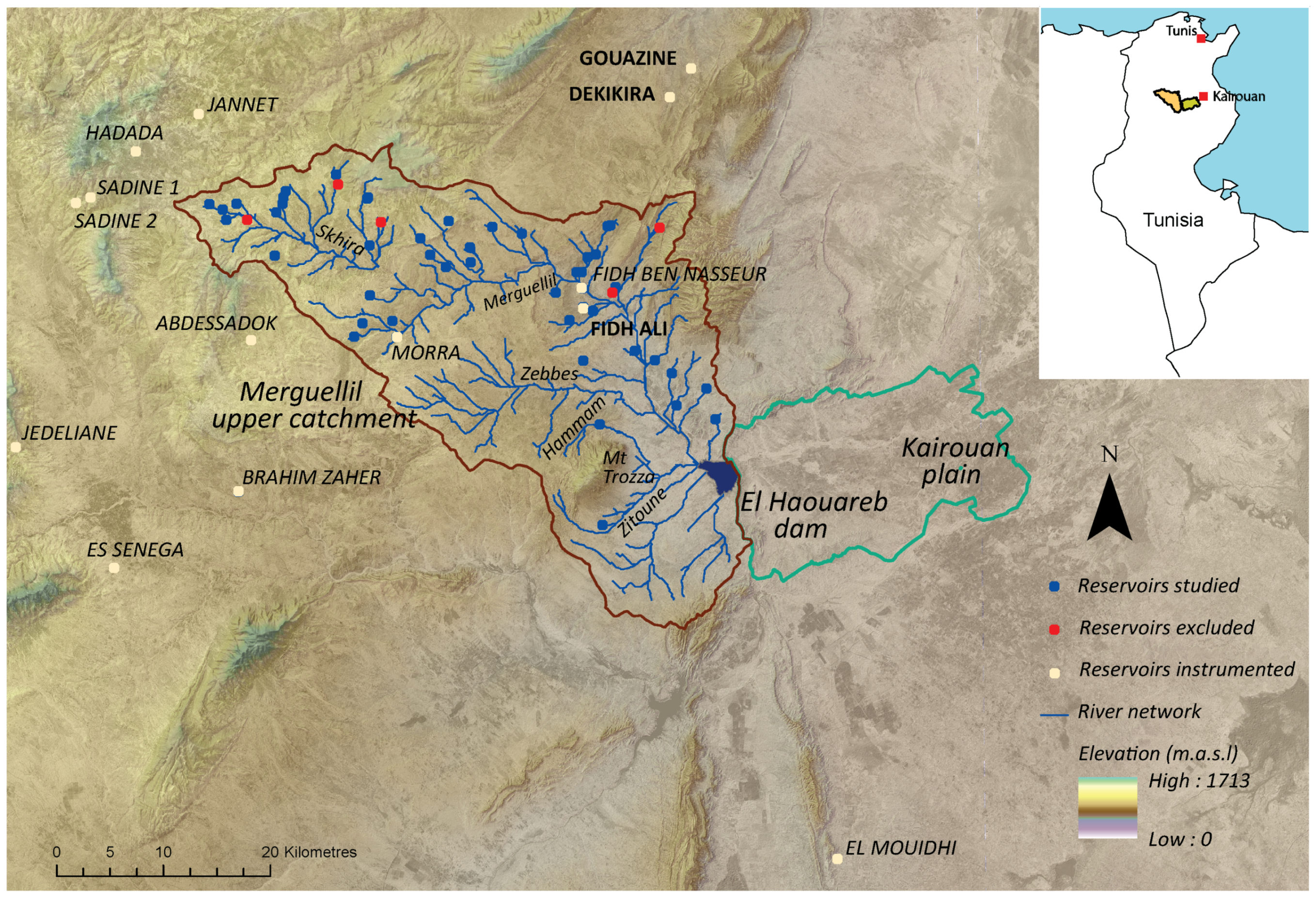
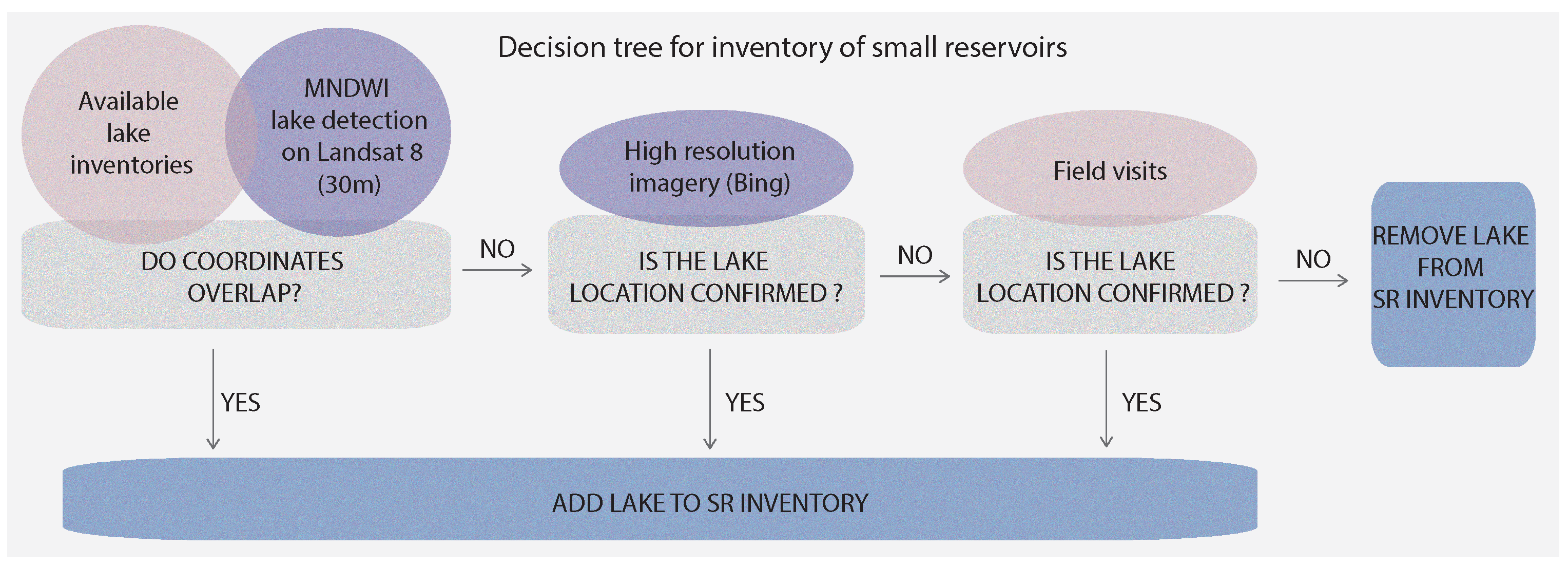
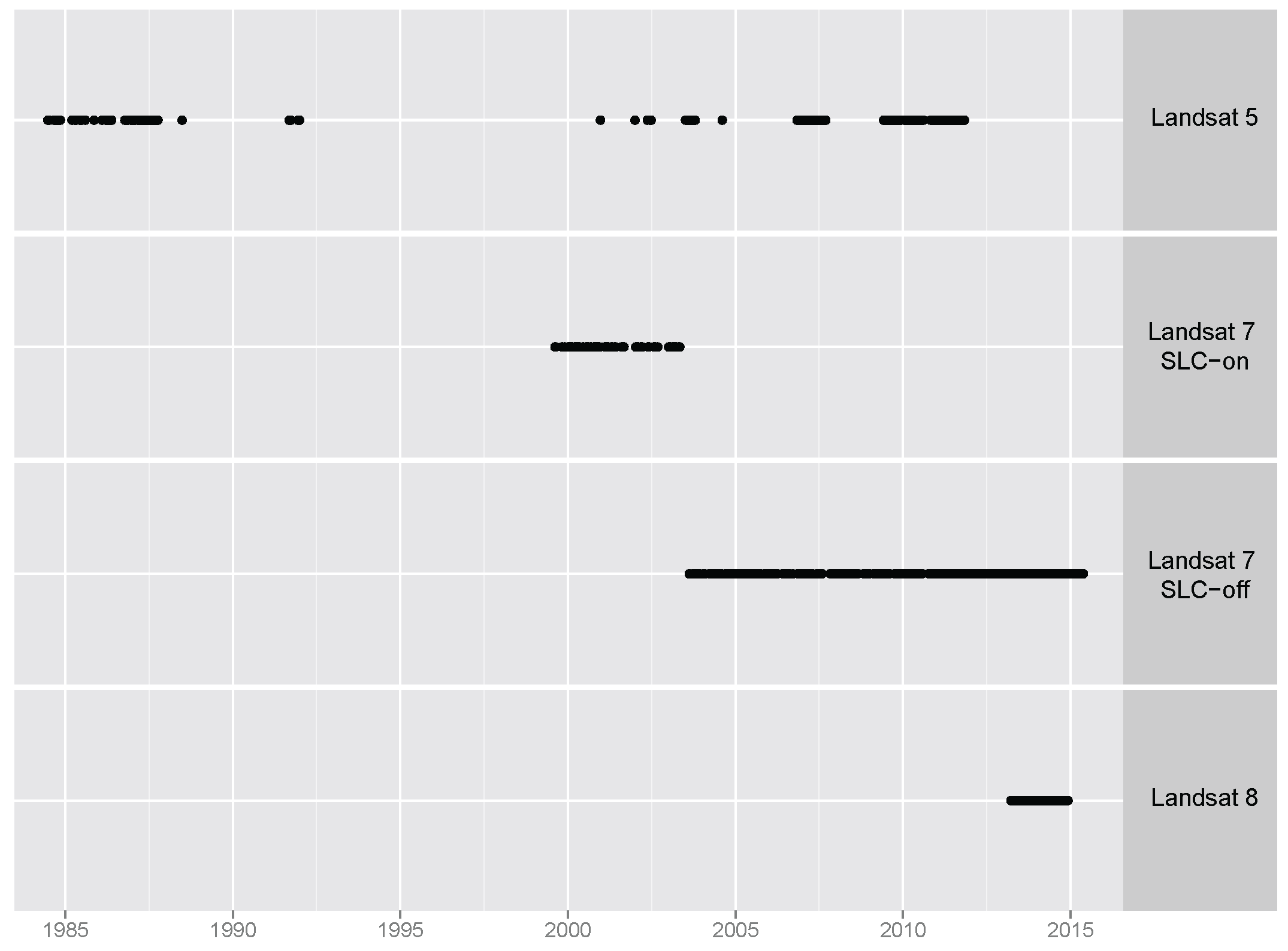
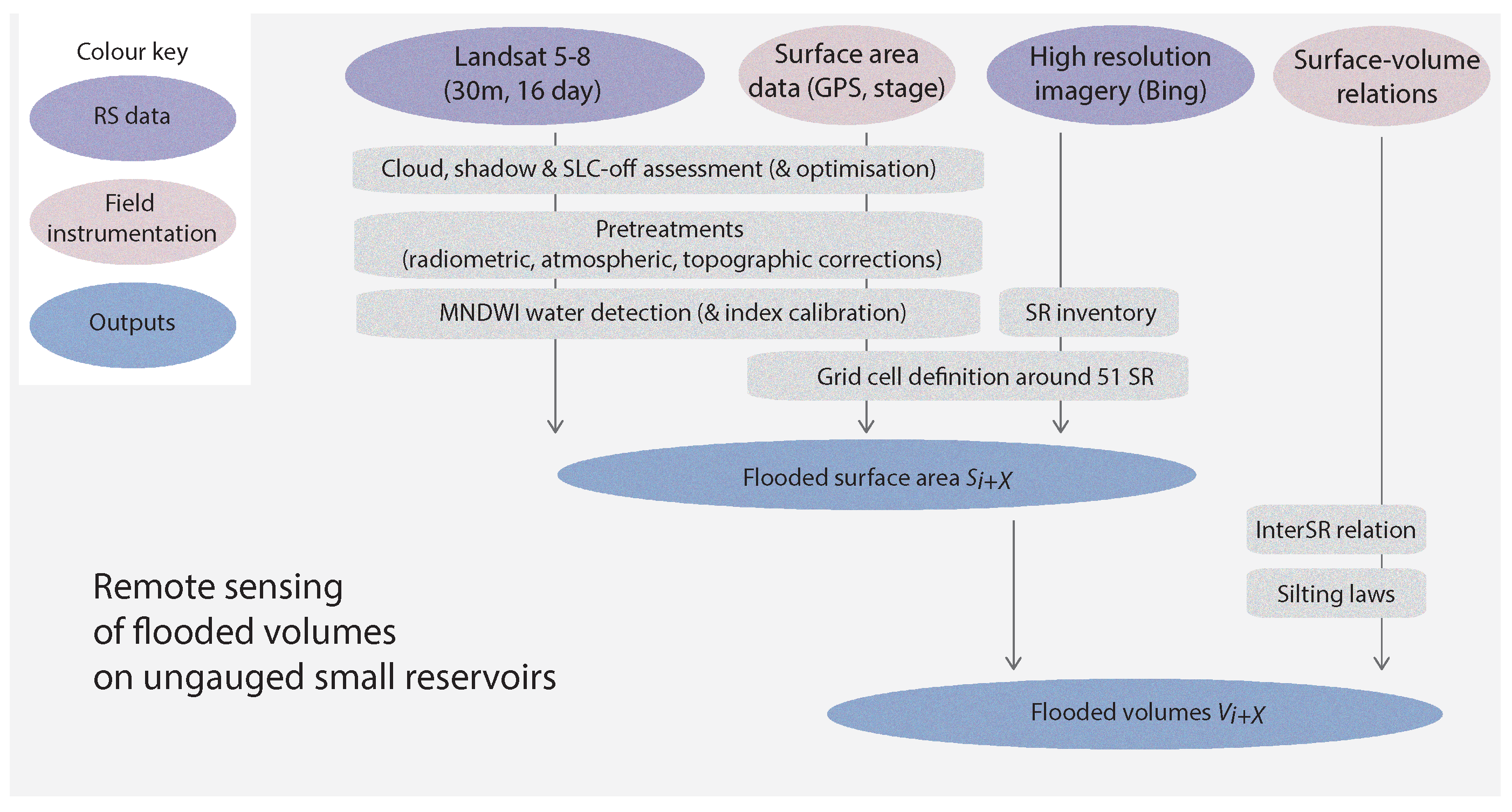
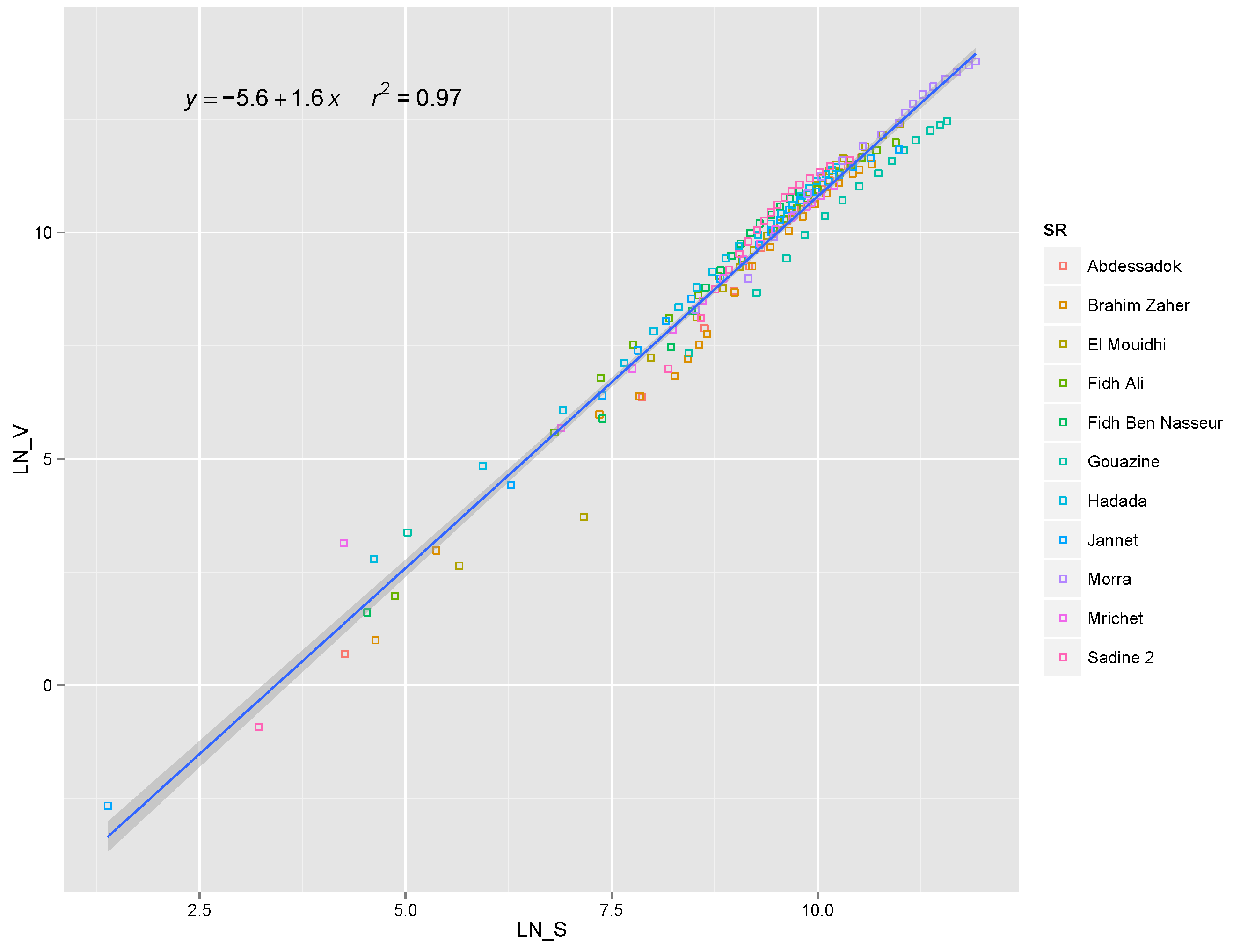
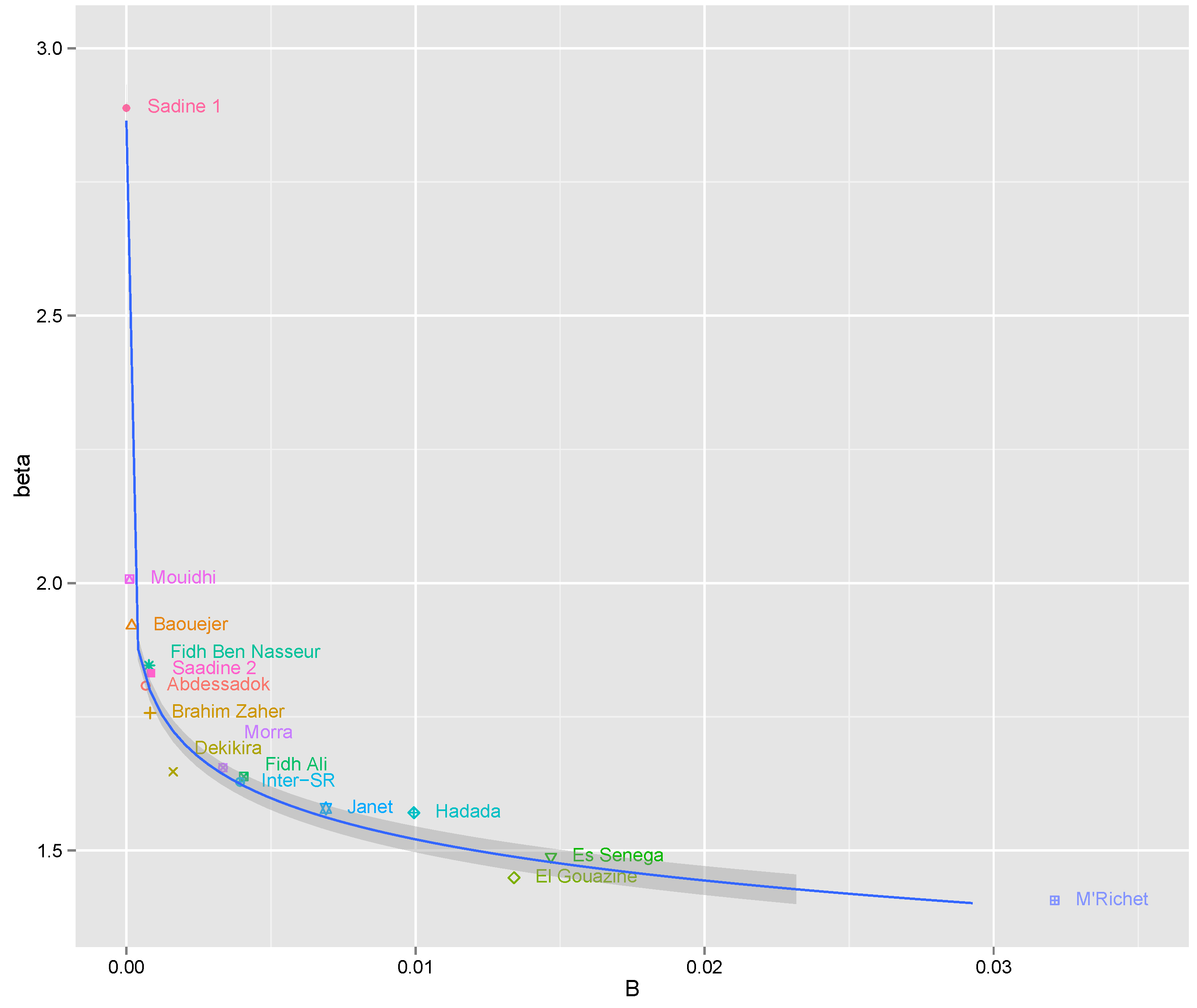



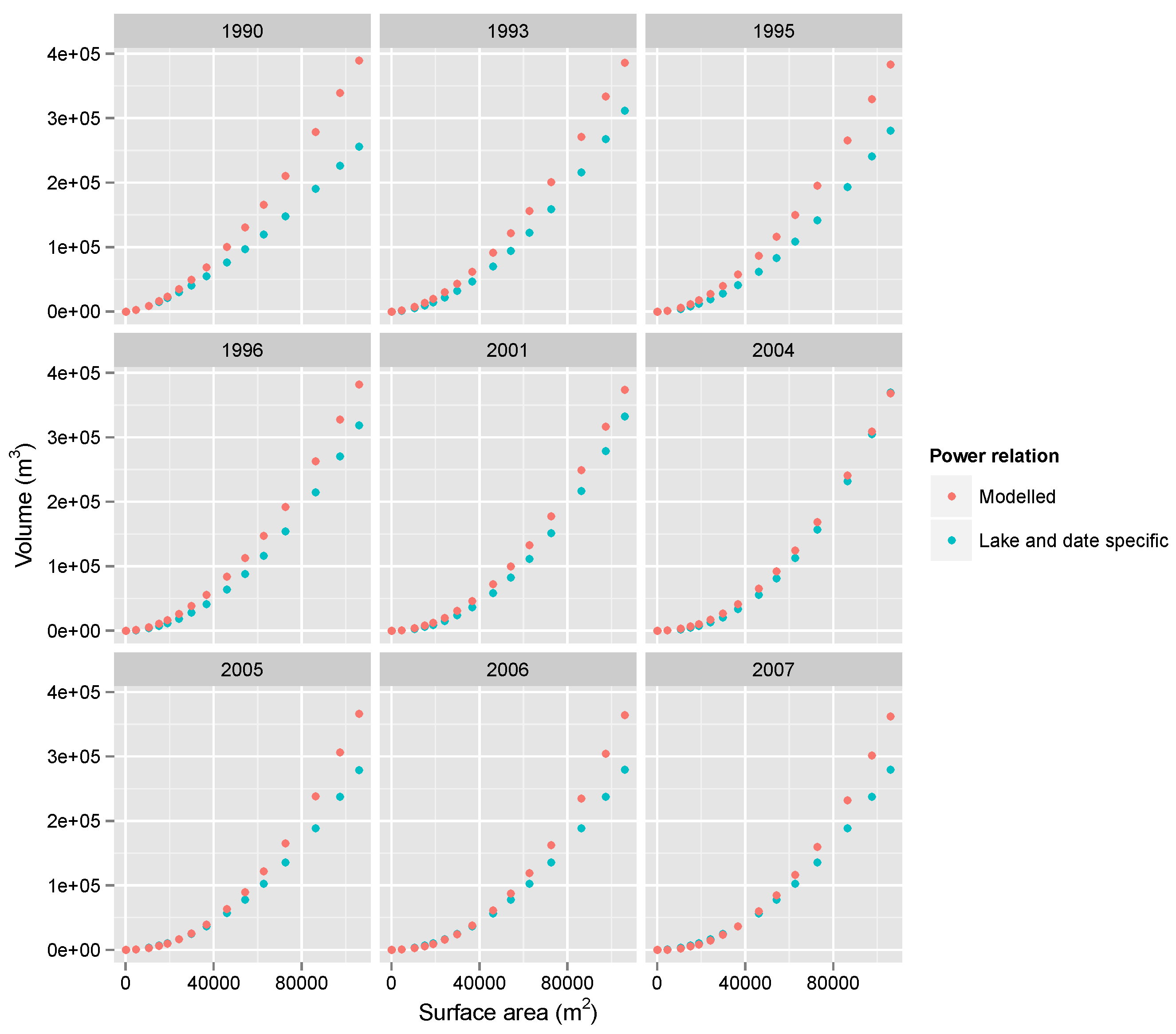

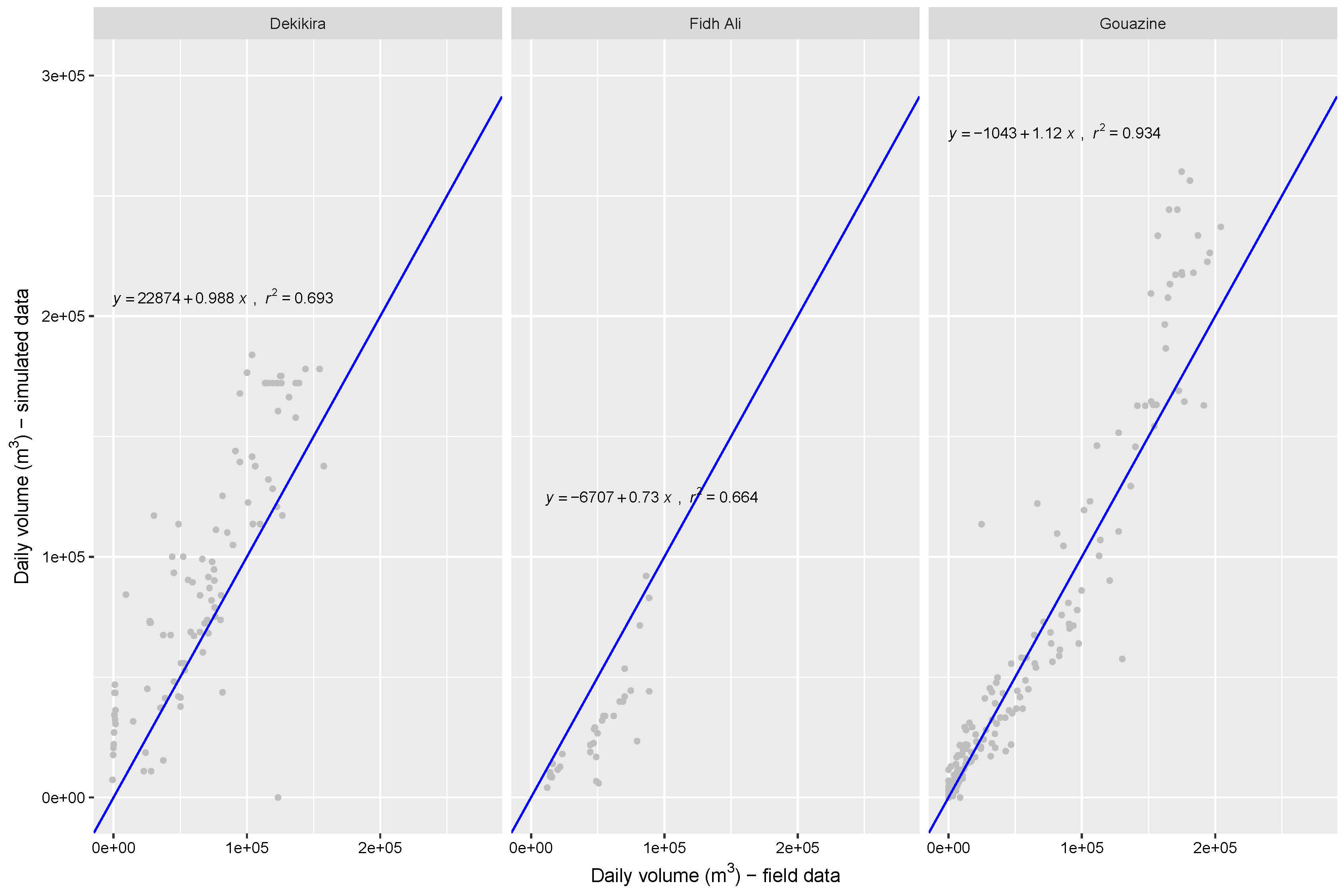


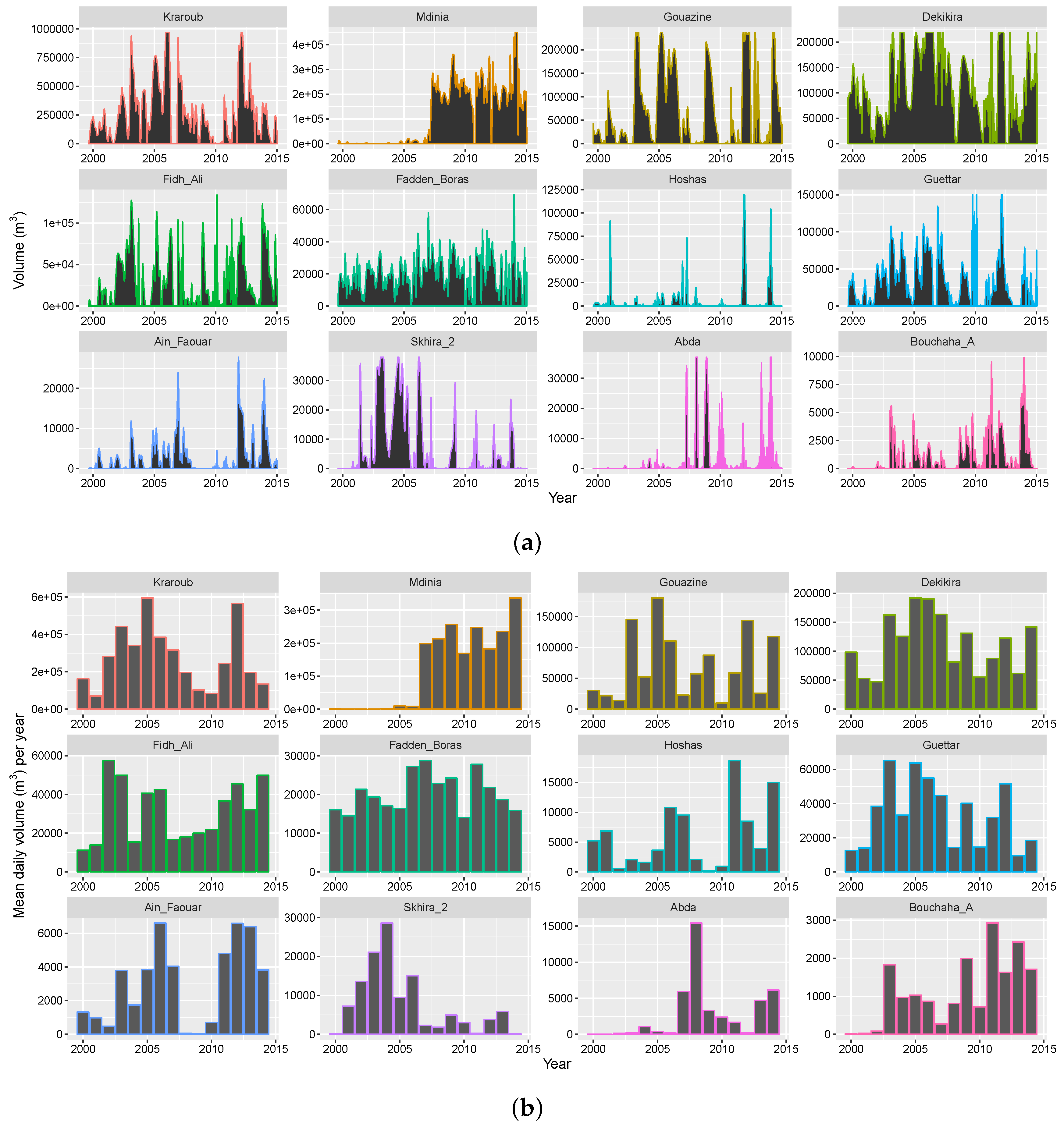

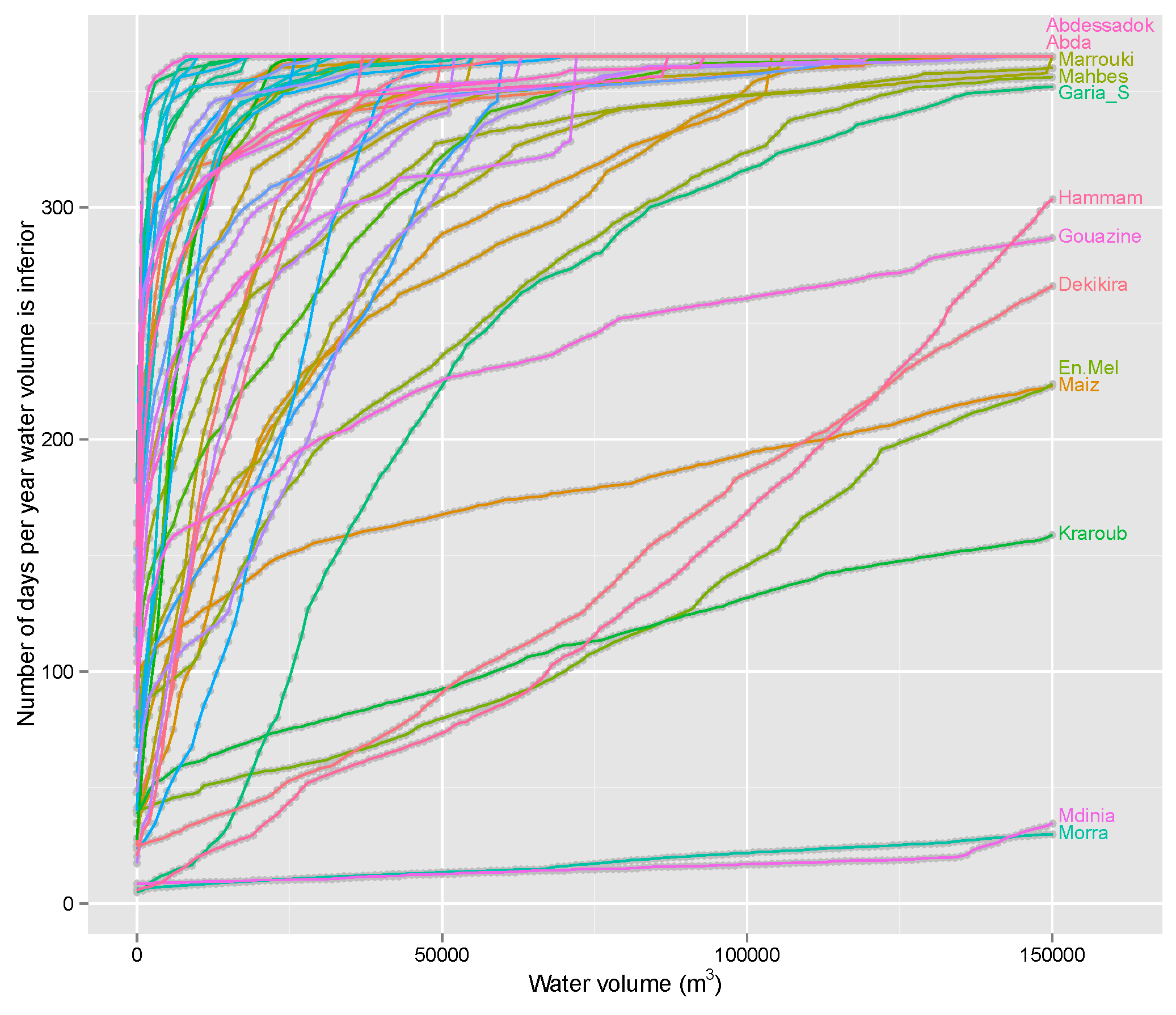
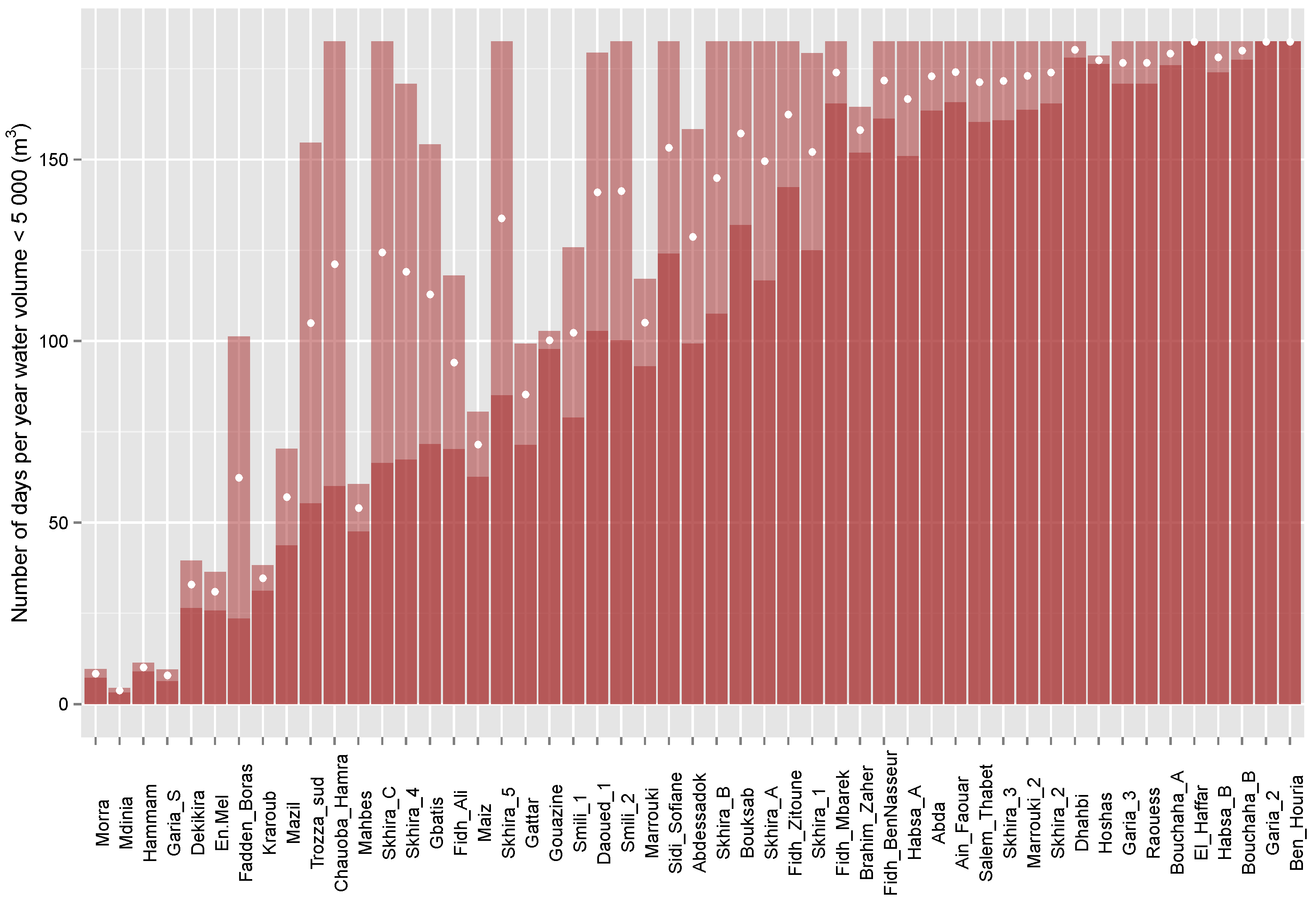
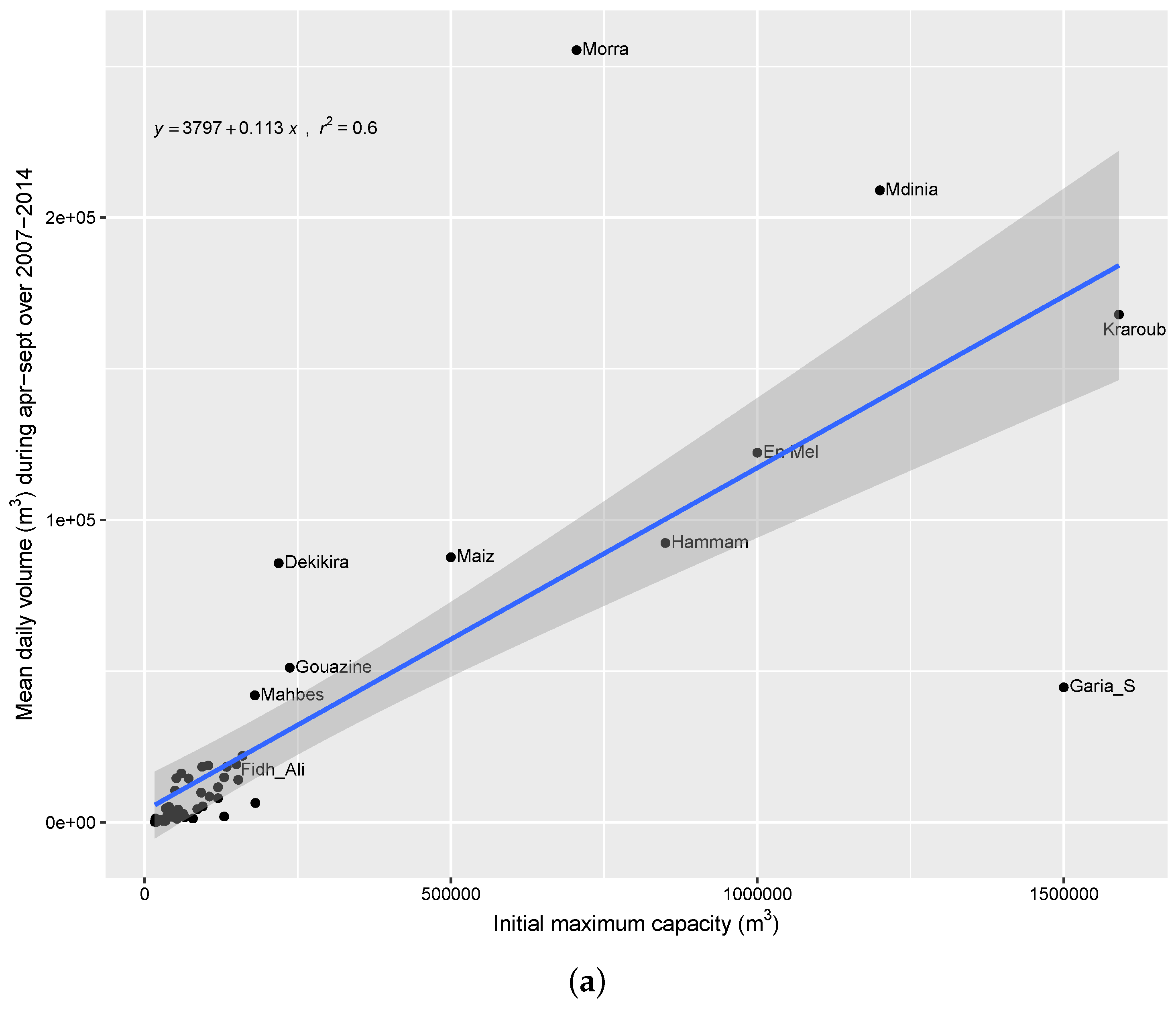

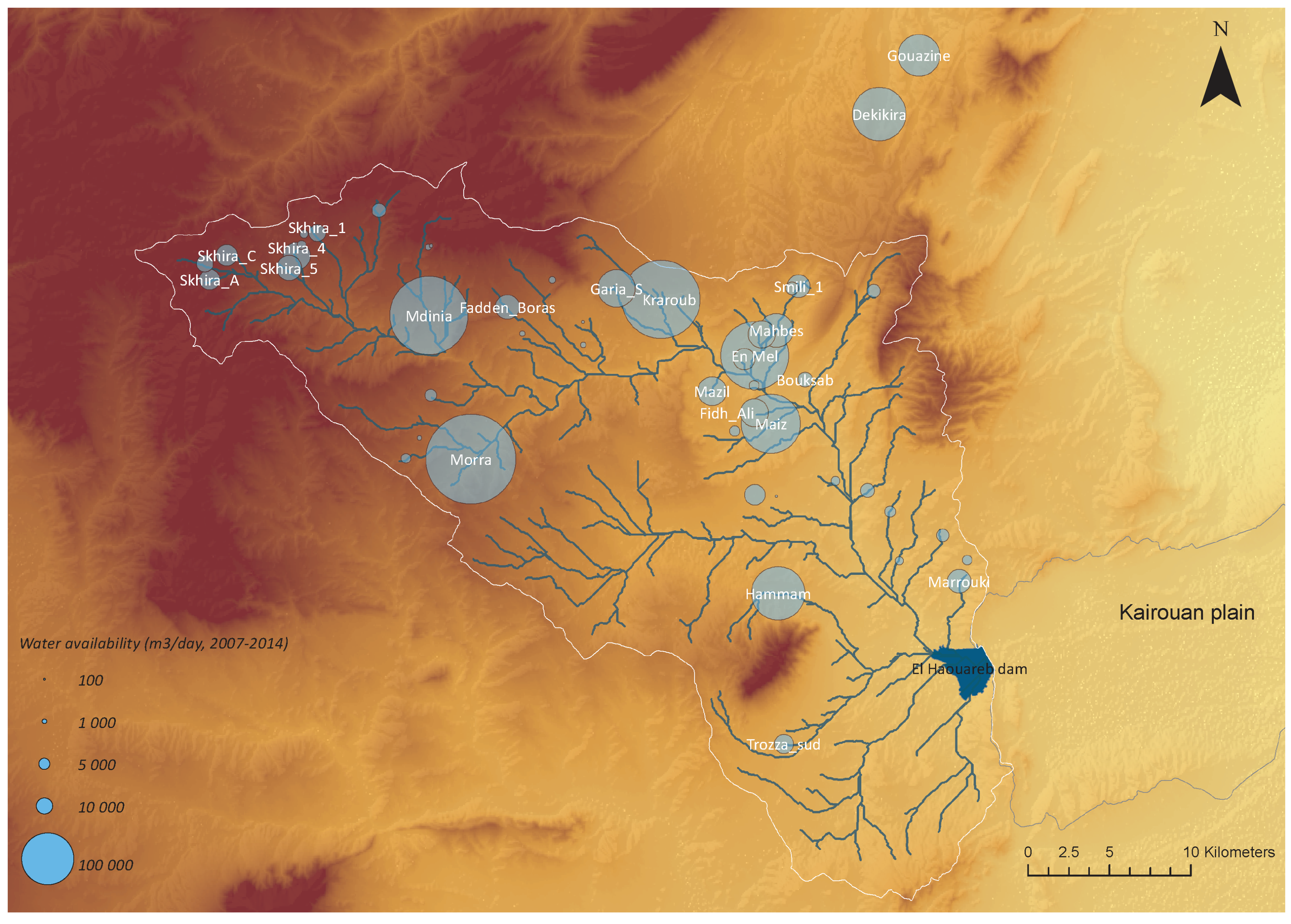
| Study | Region | β | B |
|---|---|---|---|
| Gourdin et al. [43] | Cote d’Ivoire | 1.4953 | 0.00405 |
| Cadier [42] | Brazil | 1.5882 | 0.003549 |
| Lacombe [10] | Tunisia | 1.7299 | 0.001413 |
| Liebe et al. [23] | Ghana | 1.4367 | 0.00857 |
| Sawunyama et al. [41] | Limpopo | 1.3272 | 0.002308 |
| Ogilvie (this study) | Tunisia | 1.6282 | 0.003935 |
| Lake | Daily Volume | Mean Annual Volume | ||
|---|---|---|---|---|
| RMSE (m3) | NRMSE | RMSE (m3) | NRMSE | |
| Gouazine (2000–2014) | ||||
| site specific S-V | 17,700 | 0.17 | 14,400 | 0.14 |
| interSR & silting | 27,900 | 0.27 | 16,300 | 0.16 |
| Fidh Ali (2000–2005) | ||||
| site specific S-V | 14,200 | 0.30 | 13 100 | 0.28 |
| interSR & silting | 19,200 | 0.41 | 17,900 | 0.38 |
| Dekikira (2000–2008) | ||||
| site specific S-V | 21,500 | 0.19 | 36 600 | 0.33 |
| interSR & silting | 32,200 | 0.28 | 28,100 | 0.25 |
© 2016 by the authors; licensee MDPI, Basel, Switzerland. This article is an open access article distributed under the terms and conditions of the Creative Commons Attribution (CC-BY) license (http://creativecommons.org/licenses/by/4.0/).
Share and Cite
Ogilvie, A.; Belaud, G.; Massuel, S.; Mulligan, M.; Le Goulven, P.; Calvez, R. Assessing Floods and Droughts in Ungauged Small Reservoirs with Long-Term Landsat Imagery. Geosciences 2016, 6, 42. https://doi.org/10.3390/geosciences6040042
Ogilvie A, Belaud G, Massuel S, Mulligan M, Le Goulven P, Calvez R. Assessing Floods and Droughts in Ungauged Small Reservoirs with Long-Term Landsat Imagery. Geosciences. 2016; 6(4):42. https://doi.org/10.3390/geosciences6040042
Chicago/Turabian StyleOgilvie, Andrew, Gilles Belaud, Sylvain Massuel, Mark Mulligan, Patrick Le Goulven, and Roger Calvez. 2016. "Assessing Floods and Droughts in Ungauged Small Reservoirs with Long-Term Landsat Imagery" Geosciences 6, no. 4: 42. https://doi.org/10.3390/geosciences6040042







